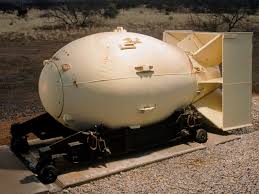Week 8 Nanotech + Art
This week was extremely hard for me to understand.I really tried to focus in on what he was saying but it seemed to go over my head sometimes. I found myself rewinding the videos constantly to see if I could make sense of what he said. After doing a little bit of research and reading our required reading for the week I was able to get a better understanding of the lecture for this weekend.
 |
| Atom Bomb |
According to Nano.gov “Nanoscience and nanotechnology are the study and application of extremely small things and can be used across all the other science fields such as chemistry, biology, physics, material science, and engineering.”
Richard Feynman is considered the father of Nanotechnology. He gave a very famous talk called “There’s plenty of room at the bottom” he also worked on the atom bomb. Feynman was reasonable for all the calculations when it came to the bomb. He also made sure that they met all the safety requirements. According to Feynman and The bomb by Alex Wellerstein Feynman told them that “50% enriched uranium in water, for example, would dangerous at a mere 350 grams of material unless there was a neutron absorbing material (cadmium) present.” It's crazy to think about how an atom bomb works. The atom is so small it can't be seen by the naked eye. It can't even be seen on some microscopes. The microscopes that can see them were recently made. How these very small or nano things can set off such a deadly and powerful explosion. The Encyclopedia Britannica states that "When a neutron strikes the nucleus of an atom of the isotopes uranium-235 or plutonium-239. It causes the nucleus to split into two fragments.”
Medieval stained glass windows are an example of how nanotechnology was used in the pre-modern. Alternate-sized gold and silver particles created colors in the stained glass windows of medieval churches hundreds of years ago.(Nano.gov) Artist back then didn't know that the beautiful work they were creating were actually changing the compositions of the materials they used. Just like Professor Vesna mentioned in the reading this week nanotechnology will soon impact all our lives.
 |
| an explosion of an atom bomb |
 |
| Medieval stained windows |
Gimzewski, Jim, and Victoria Vesna. The Nanomeme Syndrome: Blurring of Fact & Fiction in the Construction of a New Science. N.p., n.d. Web.
"What Is Nanotechnology?" What Is Nanotechnology? | Nano. N.p., n.d. Web. 29 May 2017. <https://www.nano.gov/nanotech-101/what/definition>.
The Editors of Encyclopædia Britannica. "Atomic Bomb." Encyclopædia Britannica. Encyclopædia Britannica, Inc., 27 Jan. 2017. Web. 29 May 2017. <https://www.britannica.com/technology/atomic-bomb>.
Wellerstein, Alex. "Feynman and the Bomb." Blog post. Restricted Data: The Nuclear Secrecy Blog. N.p., 6 June 2014. Web. 28 May 2017. <http://blog.nuclearsecrecy.com/2014/06/06/feynman-and-the-bomb/>.
Dr. Gimzemski. Lecture. DESMA 9. Web. 28 May. 2017.



Comments
Post a Comment